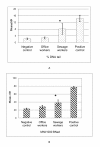Integrated exposure assessment of sewage workers to genotoxicants: an urinary biomarker approach and oxidative stress evaluation
- PMID: 21435260
- PMCID: PMC3071309
- DOI: 10.1186/1476-069X-10-23
Integrated exposure assessment of sewage workers to genotoxicants: an urinary biomarker approach and oxidative stress evaluation
Abstract
Background: Sewage workers are exposed to multiple chemicals among which many are suspected genotoxicants. Therefore, they might incur DNA damage and oxidative stress. We aimed to explore integrated urinary biomarkers, assessing the overall urine genotoxicity by in vitro comet and micronucleus assays and measuring urinary 8-oxo-2'-deoxyguanosine.
Methods: During three consecutive working days, polycyclic aromatic hydrocarbons and volatile organic compounds were sampled in workplace air of 34 sewage and 30 office workers, as indicators of airborne exposure. The last day, subjects collected their 24 hours urine. Genotoxicity of urinary extracts was assessed by comet and micronucleus assays on a HepG2 cell line. Using competitive enzymatic immunoassay we evaluated the 24 hours urinary 8-oxo-2'-deoxyguanosine excretion. Benzo(a)pyrene toxicity equivalent factors and inhalation unit risk for Benzo(a)pyrene and benzene were used to give an estimate of cancer risk levels.
Results: Workplace air concentrations of polycyclic aromatic hydrocarbons (e.g. 23.7 [range 2.4-104.6] ng.m-3 for fluoranthene) and volatile organic compounds (e.g. 19.1 ± 2.9 [standard error] μ.m-3 for benzene) were elevated in sewage compared to office workplaces (P < 0.01) and corresponded to an increased lifetime cancer risk. The urinary extracts of sewage workers showed higher genotoxicity (P < 0.001) than office workers.
Conclusions: The integrated and non-specific urinary biomarkers of exposure showed that sewage workers experience exposure to mixtures of genotoxicants in the workplace.
Figures



Similar articles
-
Biomonitoring of complex occupational exposures to carcinogens: the case of sewage workers in Paris.BMC Cancer. 2008 Mar 6;8:67. doi: 10.1186/1471-2407-8-67. BMC Cancer. 2008. PMID: 18325085 Free PMC article.
-
A multibiomarker approach to evaluate the effect of polyaromatic hydrocarbon exposure on oxidative and genotoxic damage in tandoor workers.Toxicol Ind Health. 2019 Jul;35(7):486-496. doi: 10.1177/0748233719862728. Toxicol Ind Health. 2019. PMID: 31364506
-
Biomarkers of early genotoxicity and oxidative stress for occupational risk assessment of exposure to styrene in the fibreglass reinforced plastic industry.Toxicol Lett. 2018 Dec 1;298:53-59. doi: 10.1016/j.toxlet.2018.06.006. Epub 2018 Jun 10. Toxicol Lett. 2018. PMID: 29898417
-
Genotoxicity biomarkers associated with exposure to traffic and near-road atmospheres: a review.Mutagenesis. 2013 Sep;28(5):485-505. doi: 10.1093/mutage/get042. Mutagenesis. 2013. PMID: 23945473 Review.
-
Benchmark guideline for urinary 1-hydroxypyrene as biomarker of occupational exposure to polycyclic aromatic hydrocarbons.Ann Occup Hyg. 2001 Jan;45(1):3-13. Ann Occup Hyg. 2001. PMID: 11137694 Review.
Cited by
-
Risk and Status of Gastrointestinal Cancer According to the International Standard Industrial Classification in Korean Workers.Cancers (Basel). 2022 Oct 21;14(20):5164. doi: 10.3390/cancers14205164. Cancers (Basel). 2022. PMID: 36291948 Free PMC article.
-
Goeckerman Therapy of Psoriasis: Genotoxicity, Dietary Micronutrients, Homocysteine, and MTHFR Gene Polymorphisms.Int J Mol Sci. 2019 Apr 17;20(8):1908. doi: 10.3390/ijms20081908. Int J Mol Sci. 2019. PMID: 30999684 Free PMC article.
-
Environmental and biological monitoring of exposures to VOCs in a petrochemical complex in Iran.Environ Sci Pollut Res Int. 2018 Mar;25(7):6656-6667. doi: 10.1007/s11356-017-1045-4. Epub 2017 Dec 19. Environ Sci Pollut Res Int. 2018. PMID: 29260472
-
Multi-taxon trends and the application of genotoxic biomarkers in the analysis of effluents from sewage treatment plant.Heliyon. 2023 Nov 21;9(12):e22516. doi: 10.1016/j.heliyon.2023.e22516. eCollection 2023 Dec. Heliyon. 2023. PMID: 38076150 Free PMC article. Review.
-
An Overview of Literature Topics Related to Current Concepts, Methods, Tools, and Applications for Cumulative Risk Assessment (2007-2016).Int J Environ Res Public Health. 2017 Apr 7;14(4):389. doi: 10.3390/ijerph14040389. Int J Environ Res Public Health. 2017. PMID: 28387705 Free PMC article. Review.
References
-
- Manoli E, Samara C. Occurrence and Mass Balance of Polycyclic Aromatic Hydrocarbons in the Thessaloniki Sewage Treatment Plant. J Environ Qual. 1999;28:176–187. doi: 10.2134/jeq1999.00472425002800010021x. - DOI
-
- Mulloy KB. Sewage workers: toxic hazards and health effects. Occup Med. 2001;16:23–38. - PubMed
Publication types
MeSH terms
Substances
LinkOut - more resources
Full Text Sources
Medical
Research Materials

